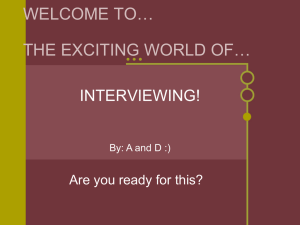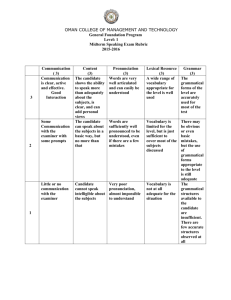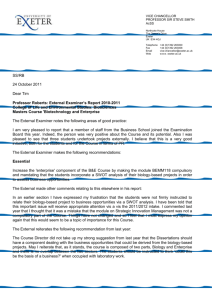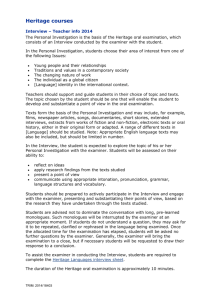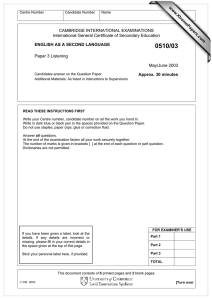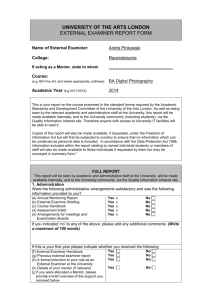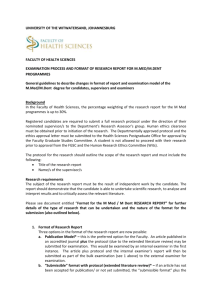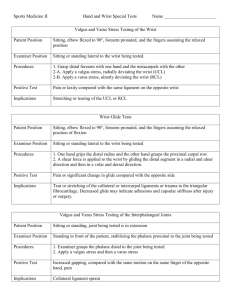tips for teaching the seventh, advanced and profieciency level exams
advertisement
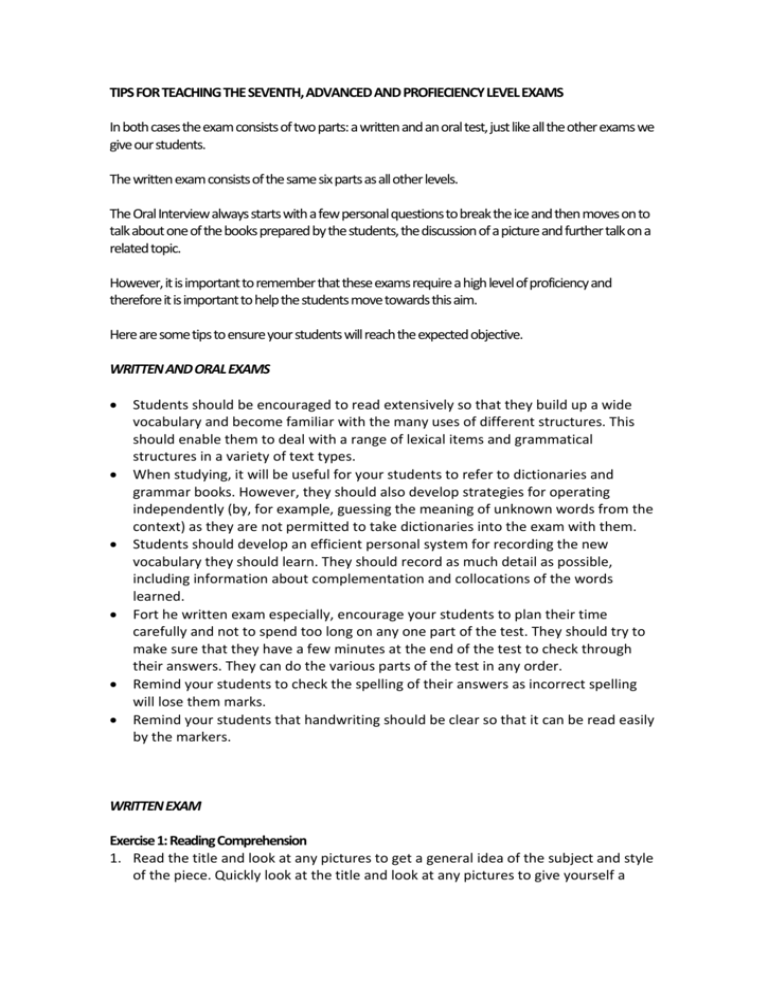
TIPS FOR TEACHING THE SEVENTH, ADVANCED AND PROFIECIENCY LEVEL EXAMS In both cases the exam consists of two parts: a written and an oral test, just like all the other exams we give our students. The written exam consists of the same six parts as all other levels. The Oral Interview always starts with a few personal questions to break the ice and then moves on to talk about one of the books prepared by the students, the discussion of a picture and further talk on a related topic. However, it is important to remember that these exams require a high level of proficiency and therefore it is important to help the students move towards this aim. Here are some tips to ensure your students will reach the expected objective. WRITTEN AND ORAL EXAMS Students should be encouraged to read extensively so that they build up a wide vocabulary and become familiar with the many uses of different structures. This should enable them to deal with a range of lexical items and grammatical structures in a variety of text types. When studying, it will be useful for your students to refer to dictionaries and grammar books. However, they should also develop strategies for operating independently (by, for example, guessing the meaning of unknown words from the context) as they are not permitted to take dictionaries into the exam with them. Students should develop an efficient personal system for recording the new vocabulary they should learn. They should record as much detail as possible, including information about complementation and collocations of the words learned. Fort he written exam especially, encourage your students to plan their time carefully and not to spend too long on any one part of the test. They should try to make sure that they have a few minutes at the end of the test to check through their answers. They can do the various parts of the test in any order. Remind your students to check the spelling of their answers as incorrect spelling will lose them marks. Remind your students that handwriting should be clear so that it can be read easily by the markers. WRITTEN EXAM Exercise 1: Reading Comprehension 1. Read the title and look at any pictures to get a general idea of the subject and style of the piece. Quickly look at the title and look at any pictures to give yourself a 2. 3. 4. 5. 6. 7. general idea of the subject and style of the piece, don’t read the text until you have analysed the questions. Read the questions carefully and underline the key expressions in each one to help focus your mind on what you are reading for. Try and remember these key expressions as you read the text at a reasonably fast pace. Some of the answers will be obvious as you read, fill in your answer sheet as you go along. Now start reading the text to understand the topic, style and tone of the piece. The questions are in the order of the text, so you can use the question stems to locate the exact part of the text that will provide the answers. Be careful that your answers match all of the information in the question. Sometimes the question will be looking for more than just one criteria so you need to be careful. Go back to the unanswered questions, look at the key expressions you underlined and try to remember which area of the text had material related to them. When you are scanning the text, try to keep several questions in mind at once to make more efficient use of your time. Exercises 2 and 3: Vocabulary and Syntactic Cloze 1. Read the text quickly to understand the topic, style and tone of the piece. 2. Now read again and try to guess what word might fill the gap. 3. Pay close attention to the words before and after the gaps, they will determine what words can and can’t be used. 4. If you don’t know what the missing word is, read the whole sentence again carefully and identify what function it has: is it a pronoun? an auxiliary verb? part of a phrasal or prepositional verb? part of an expression? Analyse the sentence to find out what is missing. 5. There may be more than one acceptable answer for a question. However, you should only give one answer for a question. If you give two answers, and one of them is incorrect, they will not be given a mark. Exercise 4: Verb Tenses 1. Read over the entire text once quickly. Take note of the topic, the style and the tone of the piece. 2. Now read it again more carefully using the correct form of the verbs in brackets and paying close attention to the time markers to make your decision. 3. Be espeacially weary of time shifts that are indicated by contextual clues even when no specific marker is used. 4. Make sure that when you see a + sign you use an appropriate modal. Sometimes more tan one may be aceptable and all apropriate options will be considered correct. Exercise 5: Dialogue Completion 1. Read over the entire dialogue once quickly to make sure you understand the overall topic being dicussed, who the participants are, what the relationship between them is and what level of formality they should use. 2. Now read it again more carefully and decide how you might complete the speakers’ words. Look for clues in the preceding and following statements or questions. These will always contain hints to guide you. In most cases there is more tan one aceptable way of completing the dialogue. However, it is important that you don’t just repeat the words provided in the clue before or after. You must try and use your own words as far as posible to demonstrate your command of the language. 3. When a stem is provided, there is only one correct option, so you must make sure that your decisión is both appropriate in terms of style and correct in terms of grammar. This is the most difficult part of the dialogue completion task. 4. Reread the whole completed dialogue to make sure that there are no unncessary repetitions and that the conversation flows naturally and is cohesive and coherent. Exercises 6: Writing 1. You have a choice of tasks. You will be able to choose from a range of subject matter and a number of different writing formats: a review, a letter/email, a report or an argument.Check the style guides for a quick overview of the different requirements of these formats. 2. Select the question you wish to answer based on your familiarity with the writing style required, your interest in the topic, and your range of vocabulary related to the topic. 3. Read the question carefully and underline the task (usually the task will have two or three parts) and the target reader. This will help you ensure you answer the question completely and use the correct level of formality. 4. Make a plan before you begin writing. This will not only improve your organization, but writing down the information will allow you to concentrate on the language ORAL INTERVIEW The speaking test is a test of communication. You don’t have to speak quickly, you don’t have to hurry your answers, and you don’t have to worry about your accent. To get a good mark on the speaking test you need to produce relevant, informative answers to the examiner’s questions. It is very important that you listen carefully to the examiner and read any material you are given carefully as well. Oral Interview Part 1 First you will be asked questions about yourself. Topics will be home, work, school, hobbies, habits, interests and future plans. Be relaxed and natural. Smile. Be the kind of person who is nice to have a conversation with! Give honest answers even if you think they are “not good”. Your opinions and lifestyle are not part of the marking criteria. Don’t give one-word answers! The examiner will not ask you follow-up questions. Give complete answers. “Because” should be your favourite word in this part of the test. Oral Interview 2 You will be asked to talk about one of the books you read. It is very important that you prepare this part of the exam carefully as it can earn you up to five marks of the total if properly carried out. Give a brief account of the plot. Don’t make it too long, as it is likely to become uninteresting if you want to provide a full straight line of events. Instead: Comment on the characters, their motivations and characteristics. Explain what you think the main theme or message is. How does it relate to other aspects of your own world today. Consider the reasons why you might recommend or not the book to others. Oral Interview 3 The examiner will show you a picture and ask questions. Please do NOT simply describe the picture! You will rarely be asked what you see in the picture. Instead, you should talk about what the picture evoques or makes you think of. Any provocative answer is welcome and likely to help you earn a better mark. Oral Interview 4 The examiner will simply ask you further questions. This part of the test is like a normal conversation with the people sitting at the table with you. Don’t give one-word answers. You are supposed to dominate the interaction, not the examiner. Give your honest opinion and don’t hesitate to react to what the other candidate says. Try and use varied structures and vocabulary to show your command of the language. During the Oral Interview You will be marked in the following categories: Grammatical Usage: measures the range and accuracy of simple and complex grammatical structures Vocabulary: measures the range and appropriacy of vocabulary Discourse Management: measures the ability to logically connect phrases to form coherent and relevant answers to the tasks Pronunciation: measures the ability to form intelligible speech, includes stress and intonation as well as individual sounds Interactive Communication: measures the ability to take an active role in the development of discussions by taking time to speak and also inviting others to speak



